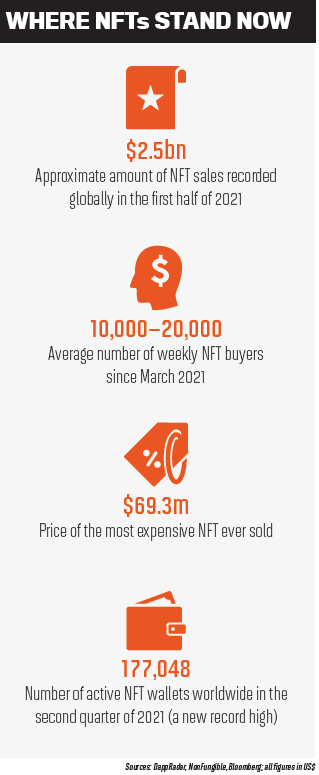

The high-profile sale of the digital artwork “Everydays: The First 5,000 Days” by the artist Beeple for US$69m in March revealed the staggering possibilities that lie within the rapidly growing non-fungible token (NFT) marketplace. NFTs are rapidly proving to be the hottest new trend in the crypto world – artists, celebrities and companies have all jumped on the bandwagon of this digital asset craze.
According to Will Turvey, divisional director of Gallagher’s fine art, jewellery and specie team, while NFTs are still the fresh-faced new entrant to the collectibles market, they are showing signs of rapid growth – during the first quarter of 2021, NFT sales exceeded $2bn.
“As the traditional art market works to find ways to enter this space, the core NFT digital art community continues to grow at a rapid pace,” says Adrienne Reid, vice president at Aon Huntington T. Block Insurance Agency. “The market shows lots of speculative trading occurring now, along with high volumes being sold on online gaming and sports platforms.”
So what’s behind crypto art’s spike in popularity? Due to the rise of screen time over the past year, Reid says, people have become more comfortable with performing transactions online. This behavioural change, coupled with the splash of NFTs in the art market, has resulted in increased interest in this space. And with the growth in the value of cryptocurrencies, items that hold digital scarcity are in demand – and that’s exactly what an NFT offers.
“The global pandemic coincided with a 600% year-over-year price increase in the crypto asset, Ethereum, which serves as the most common instrument for buying NFTs,” says Dennis Lawrence, an intelligence analyst at Aon Cyber Solutions. “As a result, newly wealthy crypto asset owners have discovered NFT artwork as a method to both enjoy their recent windfalls while hoping their artwork appreciates in value over time as a speculative investment.”
While NFTs have only recently exploded into public consciousness, they’ve been around the digital art world for several years, which means insurers and brokers in the fine art space have been mulling how the development of the NFT market will impact insurance services for some time now. Turvey points out that insuring NFTs is very different than insuring physical artwork.
“Typical fine art insurance covers physical loss or damage to the artwork,” he explains. “An NFT doesn’t give the owner exclusive access to the artwork associated with it, given the artwork has been digitised. We can all view digital art in the same way the owner of the NFT can – but we don’t all have a time and date stamp to prove that we own the authentic original. As such, what we are insuring for NFTs in the fine art insurance space is not the artwork itself, but the private key that proves ownership, which is stored offline and usually with a third-party custodian that specialises in the storage of these keys.”
Because the insurance market for NFTs and cryptocurrency is currently in its infancy, Turvey says, there isn’t as much capacity as there is for typical fine art. This means available limits will not be vast, regardless of the value of the NFT. However, he says, that should change as insurers look for new growth opportunities.
Honor Palmer-Tomkinson of Howden’s fi ne art and specie division notes that there’s a huge opportunity for underwriters and brokers to understand the crypto world and the new risks this evolving industry creates. With a wealth of experience in insuring items of high value, the fi ne art and specie insurance market is best positioned to do this, Palmer-Tomkinson says.
“Howden has been working on a solution that tailors the already solidified crypto-currency insurance products to cover NFTs,” she says. “The product that we can currently offer our clients is limited to NFTs being held in cold storage [offline] by third-party custodians and can be insured on an agreed value basis. NFTs don’t have to attach to an artwork. As an asset with a high value, an NFT attaching to a tweet or meme could potentially be insured in exactly the same way. This is a constantly evolving space, and we are enjoying the challenge of evolving along with it.”
Reid points out that the risks associated with NFTs primary revolve around a need for technology-related solutions and due diligence. Important key points for collectors include settling up multi-key verification for wallet recovery keys, having secure storage for digital asset backups, pinning the underlying digital asset to retain control over the NFT image’s accessibility, and properly reviewing the NFT licensing agreement to understand allowed reproduction abilities. Overall, she says, this space is in its very early stages, and the surrounding legal, regulatory, tax and insurance implications will take some time to work out.
Lawrence adds that other areas of concern in the NFT marketplace are counterfeit and custody risks.
“For example, hackers have recently conducted tests to expose how a bad actor can create highly sophisticated counterfeit NFTs that appear legitimate on the block-chain,” he says. “As a result, conducting due diligence on NFT artwork will help mitigate some of this risk. With respect to custody, solutions that address decentralised storage, backups and mitigation of risks associated with a user’s private key will help prevent loss or theft.”

